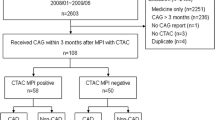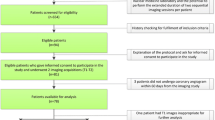Abstract
The aim of this study was to determine the yield of attenuation correction in myocardial perfusion imaging (MPI), before and after a 1-year experience period. In 48 consecutive patients referred for MPI, both non-corrected (NC) and attenuation-corrected (AC) images were analysed by three independent readers shortly after implementation of attenuation correction. The same images were re-analysed 1 year later, after having obtained experience in attenuation correction on a routine basis in >500 patients with clinical feedback. Results were compared with gold standards for ischaemia and infarction based on coronary angiography, follow-up, ultrasound and gated blood pool imaging. Sensitivity and specificity for the detection of coronary artery disease were 95% and 45% respectively for NC images and 77% and 70% respectively for AC images at first readings. After 1 year of AC experience, NC sensitivity/specificity was 100%/61%, and AC results were 89%/92%. It is concluded that attenuation correction improves the performance of MPI interpretation. With attenuation correction, specificity is increased and sensitivity is similar as compared with NC images. However, attenuation correction requires experience and is associated with a learning curve.


Similar content being viewed by others
References
DePuey EG. How to detect and avoid myocardial perfusion SPECT artifact. J Nucl Med 1994; 35:699–702.
DePuey EG, Garcia EV. Optimal specificity of thallium-201 SPECT through recognition of imaging artifacts. J Nucl Med 1989; 30:441–449.
Miles J, Cullom SJ, Case JA. An introduction to attenuation correction. J Nucl Cardiol 1999; 6:449–457.
Corbett JR, Ficaro EP. Clinical review of attenuation-corrected cardiac SPECT. J Nucl Cardiol 1999; 6:54–68
Gallowitsch HJ, Sykora J, Mikosch P, et al. Attenuation-corrected thallium-201 single photon emission tomography using a gadolinium-153 moving line source: clinical value and the impact of attenuation correction on the extent and severity of perfusion abnormalities. Eur J Nucl Med 1998; 25:220–228.
Kjaer A, Cortsen A, Rahbek B, Hasseldam H, Hesse B. Attenuation and scatter correction in myocardial SPET: improved diagnostic accuracy in patients with suspected coronary artery disease. Eur J Nucl Med Mol Imaging 2002; 29:1438–1442.
Links JM, DePuey EG, Taillefer R, Becker LC. Attenuation correction and gating synergistically improve the diagnostic accuracy of myocardial perfusion SPECT. J Nucl Cardiol 2002; 9:183–187.
Shotwell M, Singh BM, Fortman C, Bauman BD, Lukes J, Gerson MC. Improved coronary disease detection with quantitative attenuation-corrected Tl-201 images. J Nucl Cardiol 2002; 9:52–62.
Gallowitsch HJ, Unterweger O, Mikosch P, et al. Attenuation correction improves the detection of viable myocardium by thallium-201 cardiac tomography in patients with previous myocardial infarction and left ventricular dysfunction. Eur J Nucl Med 1999; 26:459–466.
Hendel RC, Berman DS, Cullom SJ, et al. Multicenter clinical trial to evaluate the efficacy of correction for photon attenuation and scatter in SPECT myocardial perfusion imaging. Circulation 1999; 99:2742–2749.
Lee DS, So Y, Cheon GJ, Kim KM, Lee MM, Chung JK, Lee MC. Limited incremental diagnostic values of attenuation-noncorrected gating and ungated attenuation correction to rest/stress myocardial perfusion SPECT in patients with an intermediate likelihood of coronary artery disease. J Nucl Med 2000; 41:852–859; discussion 860–862.
Vidal R, Buvat I, Darcourt J, Migneco O, Desvignes P, Baudouy M, Bussiere F. Impact of attenuation correction by simultaneous emission/transmission tomography on visual assessment of201Tl myocardial perfusion images. J Nucl Med 1999; 40:1301–1309.
Wackers FJ. Should SPET attenuation correction be more widely employed in routine clinical practice? Against. Eur J Nucl Med Mol Imaging 2002; 29:412–415.
Diamond GA, Forrester JS. Analysis of probability as an aid in the clinical diagnosis of coronary-artery disease. N Engl J Med 1979; 300:1350–1358.
O'Connor MK, Kemp B, Anstett F, et al. A multicenter evaluation of commercial attenuation compensation techniques in cardiac SPECT using phantom models. J Nucl Cardiol 2002; 9:361–376.
Wacker FJT. Attenuation correction, or the emperor's new clothes? [editorial] J Nucl Med 1999; 40:1310–1312.
Hendel RC, Corbett JR, Cullom SJ, DePuey EG, Garcia EV, Bateman TM. The value and practice of attenuation correction for myocardial perfusion SPECT imaging: a joint position statement from the American Society of Nuclear Cardiology and the Society of Nuclear Medicine. J Nucl Cardiol 2002; 9:135–143.
Author information
Authors and Affiliations
Corresponding author
Rights and permissions
About this article
Cite this article
Slart, R.H.J.A., Que, T.H., van Veldhuisen, D.J. et al. Effect of attenuation correction on the interpretation of 99mTc-sestamibi myocardial perfusion scintigraphy: the impact of 1 year's experience. Eur J Nucl Med Mol Imaging 30, 1505–1509 (2003). https://doi.org/10.1007/s00259-003-1265-3
Received:
Accepted:
Published:
Issue Date:
DOI: https://doi.org/10.1007/s00259-003-1265-3




